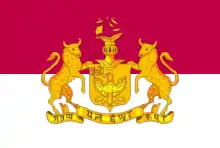Rajputs in Gujarat
The Rajputs in Gujarat, or Gujarati Rajputs are members of the Rajput community living in the western Indian state of Gujarat. They ruled several dynasties and princely states during the British era. Some Rajput clans of Gujarat have origins from outside regions such as Rajasthan, while others are native to the region.
History, clans, and dynasties
Solanki dynasty

The Chaulukyas, also known as the Solankis, ruled parts of what are now Gujarat and Rajasthan in north-western India, between the 10th and 12th centuries [1]
Vaghela dynasty & clan
The Vaghela dynasty were an offshoot vassal clan connected to the Chaulukya dynasty, ruling Gujarat in the 13th century CE. Their capital was Dholka. They were the last Hindu dynasty to rule Gujarat before the Muslim conquest of the region.[3]
Early members of the Vaghela family served the Chaulukyas in the 12th century CE, and claimed to be a branch of that dynasty. In the 13th century, during the reign of the weak Chaulukya king Bhima II, the Vaghela general Lavanaprasada and his son Viradhavala gained a large amount of power in the kingdom, although they continued to nominally acknowledge Chaulukya suzerainty. In the mid-1240s, Viradhavala's son Visaladeva usurped the throne, and his successors ruled Gujarat until Karna Vaghela was defeated by Nusrat Khan[4] of the Delhi Sultanate in 1304 CE, and lost Gujarat.
Gohil clan

The Gohil dynasty or Gohil or Guhilas of Saurashtra ruled parts of Saurashtra region of present-day Gujarat state of India as subordinates or independents starting 12th century. Their origin is traced to the Guhila dynasty of Mewad in Rajasthan and they had migrated to Saurashtra in 12th century. The earliest known inscription of Gohils is found from Mangrol.
Chavda clan

The Chavda Rajputs were one of the predomiant Rajput clans were found in Kutch and Saurashtra.
Chudasama dynasty

The Chudasama dynasty ruled parts of the present-day Saurashtra region of Gujarat state in India between the 9th and 15th centuries. Their capital was based in Junagadh and Vamanasthali, and they were later classified among the Rajput clans.[5] They claimed to be of Lunar race from which the deity Krishna sprung, and are off-shoots of the Samma dynasty which ruled Sindh.
Jethwa dynasty
_(14594436738).jpg.webp)
The Jethwa dynasty was a dynasty that ruled over present day Gujarat region of India from 7th century AD till middle of 20th century, when India became independent. It was a Rajput dynasty ruled by Jethwa clan of Rajputs. Porbandar State was ruled by a Jethwa dynasty. The Jethwas are one of the oldest Rajput clans of the Saurashtra peninsula, where they established themselves in Morvi around 900 CE.
Rathod clan
The Rathod clan of Gujarat are descendants of the Rathore clan of Rajputs from Rajputana who migrated to Gujarat around the 12th century CE. Their two main branches are the Vajas and the Vadhels. Rao Sonag was the first Rao of Idar.
Sarvaiya clan
The Sarvaiya clan of Rajputs are descendants from the Chudasama Rajputs who laid their foundations at a village near Sarvi. They later adopted the Sarvaiya identity.
Parmar clan
The Parmar clan of Gujarat claims descent from the Paramara dynasty which ruled in Malwa. In Gujarat, the Parmars appeared to first have arrived in Thangadh and Chotila, after seizing the Bhil lands. They ruled Sant State, which was a 9-gun salute princely state during the British Raj. They eventually also ruled Muli State.
Vala clan
The Vala clan of Rajputs claim to be the oldest of the Saurashtra region. They trace their origin to Vallabhi, a city in Gujarat. They were petty land owning chiefs in several villages around Walak.
Jhala clan

The Jhala clan of Rajputs trace their origin to Rajasthan. They migrated to Saurashtra and eventually began to rule several villages. The region became known as Jhalawad.
Karadiya clan
The Karadiya Rajputs are a community of Rajputs in Gujarat. While having their origins in the regions of Malwa, Ujjain and Rajasthan, they are primarily found in the Saurashtra, Kutch and other region of Gujarat, India.[6]
References
- Hermann Kulke (2004). A History of India. Psychology Press. p. 117. ISBN 978-0-415-32919-4.
When Gurjara Pratiharas power declined after the sacking of Kannauj by the Rashtrakutkas in the early tenth century many Rajput princes declared their independence and founded their own kingdoms, some of which grew to importance in the subsequent two centuries. The better known among these dynasties were the Chaulukyas or Solankis of Kathiawar and Gujarat, the Chahamanas (i.e. Chauhan) of eastern Rajasthan (Ajmer and Jodhpur), and the Tomaras who had founded Delhi (Dhillika) in 736 but had then been displaced by the Chauhans in the twelfth century.
- Saxena, Anisha (2018). "Jakh, Jacks, or Yakṣa?: Multiple Identities and Histories of Jakh Gods in Kachchh". Asian Ethnology. 77 (1–2): 103. JSTOR 26604835.
- Mitra, Sudipta (2005). Gir Forest and the Saga of the Asiatic Lion. Indus Publishing. ISBN 978-81-7387-183-2.
- Kuzhippalli Skaria Mathew (1986). Portuguese and the Sultanate of Gujarat, 1500–1573. p. 98.
- J Chaube (1975). History of Gujarat Kingdom, 1458–1537. p. 16. ISBN 9780883865736.
- Shah, G. (1987). "Middle Class Politics: Case of Anti-Reservation Agitations in Gujarat (AN 160)". Economic and Political Weekly. 22 (19/21): AN155. JSTOR 4377019.